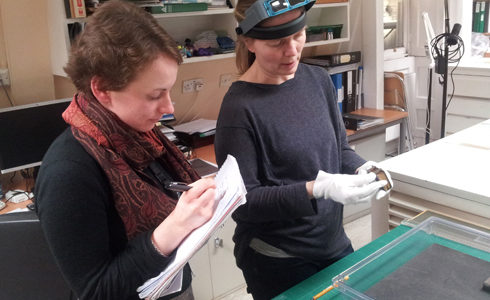Curating the the Küslins’ Bible was an attractive prospect for me as I have an academic background in Prints and printmaking and my current PhD is in Theology and the Arts.
Delving into the Protestant devotional context of Augsburg and seeing how it influenced their pictorial compositions has been an exciting opportunity.
When I first looked at this pair of miniature Bibles, I was amazed by their near perfect condition, given that they were primarily used as supports in spiritual contemplation which would mean they would have been used regularly.

In addition to limited factual documentation on the books, I soon established that finding out any information concerning the Küslin sisters themselves was going to be a tricky task – in this early stage of my research I only found one reference to them!
However, research on thumb Bibles, their function and German printmakers luckily proved to be more fruitful.
I spent a lot of time emailing many specialists and worldwide libraries, which had other sets of the Küslins’ Bible, to see what information could be found – the results confirmed I was working on some unique objects!
I also worked with The Courtauld’s Conservation team to find out about the physical make-up of the books and the cleaning had brought the silverwork back to their former glory.
Looking at the Bibles under the microscope and seeing the details of the clasps and the engravings of the putti on the mounts emphasised the pain-staking work that went into making these beautiful objects. Even the detail on the small engraved crosses was made to look like wood-grain.

The Courtauld’s Paper Conservator Kate Edmondson also gave me an insight as to which parts of the picture books were likely later additions, and the question arose as to how much of these books could definitively be dated to late seventeenth century Augsburg.

For example, the silk headbands sewn into the structure of the book to protect the top and bottom may have been re-done in the Victorian period when the books were likely to have been re-bound.
Midway through my research, a lead from the Rare Books Curator at the Bodleian Librarycame to light on a picture Bible, called the Hexastichon Hieron printed in Oxford in 1677 which used German engravings.
I went to investigate, and to my excitement the illustrations turned out to be near identical to many of the engravings in the Küslins’ Bible!
In fact, the engravings for the Oxford Bible came from Matthaeus Merian, who was the grandfather of the sisters! Comparing the Küslins’ Bible to Merian’s engravings from the Icones Biblicae at the British Museum, was enlightening.
Towards the end of my research, I started to think about how I wanted the books and labels to be displayed and show off the books to their best advantage.

A day with the professional photographer was a good way to see how carefully these valuable objects needed to be treated while taking accurate photos.
Wearing latex gloves became a constant feature!

Towards the end, getting the labels, captions and web-text finalised became the priorities. A meeting with Eva, the web-developer, threw up some inspirational ideas as to how best to represent the web page; I knew the page-turning feature would be an additional success!

The entire project was overseen by Dr. Alexandra Gerstein, who was a source of good advice and support, and special thanks to the team at the Ashmolean Prints Department, Angela Roche at the British Museum, Alan Coates at the Bodleian, Christopher Rowland, Ben Quash and Helen Hills who have all provided enormous encouragement and feedback, Christopher Mendez, John Hindmarch, Richard Valencia, and Joanna Selbourne and Kate Edmondson at The Courtauld Gallery.


